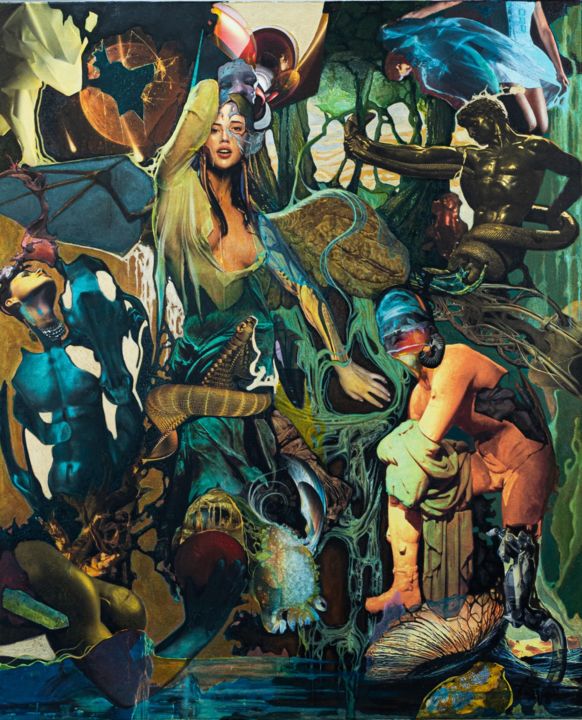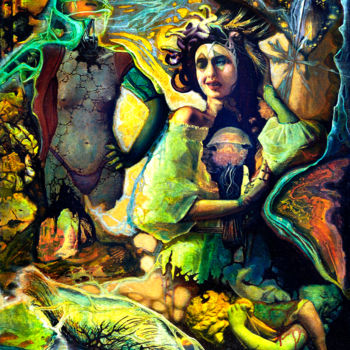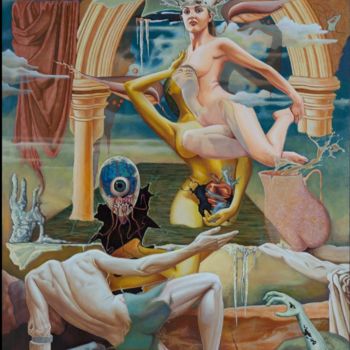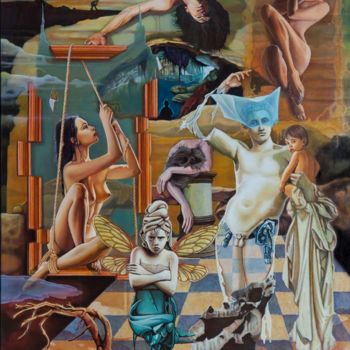Nike and Haphaestus's Kabeiri (2021) Painting by Cezar Ungureanu
Not For Sale
Sold by Cezar Ungureanu
Sold by Cezar Ungureanu
This image is available for download with a licence
Sold by Cezar Ungureanu
-
Original Artwork (One Of A Kind)
Painting,
Acrylic
/
Oil
/
Pencil
/
Pigments
/
Stencil
on Canvas
- Dimensions Height 43.3in, Width 35.4in
- Framing This artwork is not framed
- Categories Paintings from $20,000 Pop Art Gothic
The artist's dissociative reconstructivist works are essentially reconstructions, re-composed using decontexualized elements from very diverse sources.
These intrusions are often deliberately exaggerated; iconic and/or archetypal elements inserted consciously, sometimes creating the idea of polydimensional scans and of antimonies of artistic and aesthetic language; this type of reconstructivism has been very little experimented with, especially in visual arts, and then only sporadically or accidentally.
The ideatic approach of re-constructivism, the combination of archaic elements and modern ones, the antithesis between the classic visual language and the postmodern one, the digital and the pictorial, the conceptual and the formal, in a unitary ensemble, with a range of diverse compositional elements, from cave art to ultramodern – deconstructivist elements, grunge insertions, intrusions, juxtapositions and fusions of elements – antigravity, atemporality and pluridimensional effects, allow the artist to obtain an effect of outstanding harmony, integrity and agility in the resolution of composition, lending to the treatment of each topic an added emotional and visual charge.
Similar to deconstructivist fiction, Cezar Ungureanu's re-constructivist art is explicitly aware of its own status as a creation, illusion or fiction, engendering a dialogue between the viewer and the artwork, in a language that does not need to be learned; the iconic elements that raise in a way to the status of contemporary religion using classical art pictorial resources, sometimes referring directly to a previous, real or invented, piece, which, in its turn, may have been based on an earlier piece; thus, it has to depict genuine emotions or to inspire a sui generis emotional response.
Occasionally cloaked in an apparent aura of neo-surrealism, Cezar Ungureanu's dissociative reconstructivism proposes a perpetual, eclectic, syncretic reconceptualization; a permanent and arrhythmic decontextualization-recontextualization; bipolarities such as utopian/dystopian, ancient/avant-garde, formal/conceptual etc., recomposed on a classical structure, a distinctive characteristic of re-constructivism, with a nod to artifice, sometimes creating moments of genuine emotion and authentic meaning – an artificial reconstruction of a deconstructivist-illusory world with iconic elements transcontextualized in the atemporal.
Another challenge posed by the artist resides in the tension produced by the influence of deconstructivist elements adapted in order to observe a classical structure, despite the inclusion of surprising elements, creating together a conventional whole – genuine installations of canvas, sometimes resorting to a controlled Dadaism, to an ideatic and artistic reassembly – a deliberate reconstruction of reality in search of a feeling of Reality in an illusory world.
The works force the viewer to believe in one's own, more profound reality, despite acknowledging its superficial artificiality.
The work is made on canvas and mounted on a stretcher, it can be exhibited as such or it can be framed.
Related themes
A graduate of the George Enescu Academy of Arts in Iaşi, Romania, visual artist Cezar Ungureanu, active in neo-surrealist and re-constructivist painting, has also developed his artistic skills in the fresco and tempera techniques specific to monumental and mural painting, attending postgraduate courses organised by the Romanian Patriarchy's Religious Painting Committee.
The artist has already produced works in several churches in Romania and abroad, as well as a large number of oil and acrylic painting, and neo-Byzantine style religious paintings using the fresco technique, in tempera and acrylic paint.
In his DISSOCIATIVE RE-CONSTRUCTIVIST works, the artist combines the vitality of deconstructivism with the comfort and rewards of classicism, with the aim of finding a feeling of reality in an illusory world, and of producing works filled with emotion, meaning and authentic visual language.
Traditionalist in some respects and subversive in others, the artist's work revives the lost pleasures of classical art; it carries, on the one hand, the tension produced by the deconstructivist influence, and on the other hand the consonance of a classical structure, using interferences, fusions, juxtapositions of images, trompe l'oeil, pseudo-Euclidian spaces and so on. The artist's pieces have depth, intensity, and a well justified "artificial" realism.
By recomposing a "new reality" in perpetual transformation and by creating new mobile and self-explanatory contextures, the artist continues the leitmotif of antagonism and bipolarity specific to neo-realist artwork and to dissociative reconstructivist pieces, sometimes using backdrops, scenery and metallised insertions influenced by Byzantine painting and by the works of Gustav Klimt, who in his turn was captivated by the maniera greca paintings in Verona.
Some of the works are painted entirely by hand, while others combine painting with the appropriationist manipulation of images through pigment transfer, and with stencil art.
"The fruit of a fertile imaginative disposition, the works of artist Cezar Ungureanu reveal a certain surprising depth towards the sphere of mysterious revelations that assert themselves as the effect of the subconscious, sensitised and guided towards unsettling reveries, a realm of serenity, of equilibrium, a medium that gives itself off, generously, to dreaming.
We find ourselves in fact in the presence of works of elevated spirituality, suggesting the splendours of the eternal humanity, together with the discreet integration of the human being in the poignant process of Universal becoming."
A valuable past will always facilitate to the present an authentic and veritable future.
Events: Neo-Byzantine outdoor and indoor mural works, as a sole author or in collaboration, in various churches in Romania, the Republic of Moldova and in Greece.
Works in private collections in Los Angeles, Florida, New York, Boston, Denver, San Antonio, Portland, France, Italy, Germany, Romania
-
Nationality:
ROMANIA

- Date of birth : unknown date
- Artistic domains:
- Groups: Romanian Contemporary Artists









